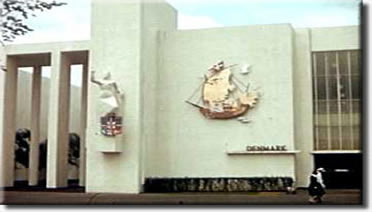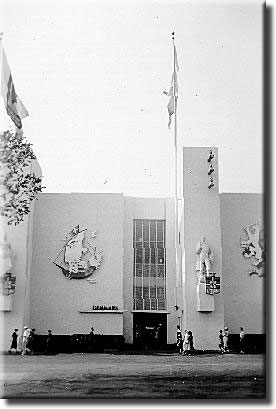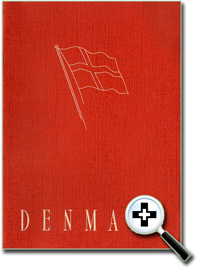While Denmark did not display any commercial products their exhibit did contain large-scale paintings showing the scenery, pictorial statistics that illustrated Denmark's industrial, educational, and commercial development and a restaurant where Danish agricultural products were served.

Image captured from Phillip A. Medicus Film

Roger Nielson, Denmark’s fair commissioner, was a best-selling author of a children’s book set in the American Wild West. Nielson wrote the volume after a chance meeting with Buffalo Bill Cody.
Anna Palme, mother of a daughter and son and an assistant designer of Denmark’s pavilion, insisted women should marry at eighteen and then pursue any given career “she might be pining for.” Ms. Palme believed “Fairs like this are so important. We are so small that we must be international.”
Anna Palme, mother of a daughter and son and an assistant designer of Denmark’s pavilion, insisted women should marry at eighteen and then pursue any given career “she might be pining for.” Ms. Palme believed “Fairs like this are so important. We are so small that we must be international.”
The darlings of the Danish exhibit were the chubby and cheerful children’s wooden toys created by Kay Bojesen. (Kay is a male name in Denmark) The highly polished playthings, executed in Danish beech wood, were without stain or color. Bojesen insisted: “Children like to imagine the colors of their toys. I leave the young imagination free. Besides, if the child should bit the wood, there’s no paint to make him ill.”
Danish modern furniture appeared to great acclaim in the country’s pavilion. Danish industrial designers styled pieces with esthetic appeal that would hold up under strong lighting. Basket furniture, constructed of interwoven flexible cane or rush, and pieces without legs fascinated New York’s design critics.
Kal Nielsen’s cast cement figure, “Eve and the Apple,” created quite a sensation at the fair. Many observers felt the life-size nude of a mother holding her baby too frank in its presentation. A woman with a bit too much to drink “recognized an old friend” and reaching out for an embrace, knocked the statue to the floor. The woman’s “friend” shattered and she ended up in tears. Danish fair commissioner Roger Nielsen cabled Denmark for another copy of the original which stood in Copenhagen’s royal gardens.
Crown Prince Frederik and Princess Ingrid visited the Fair during its opening days to open the Danish pavilion. The acting chief of foreign participation, Edward Roosevelt, helped the royal pair on an incognito tour utilizing a tractor train as “cover.” The princess created a fashion sensation wherever she went. At a cocktail party hosted by the Iceland fair commission at the fair’s fashionable Terrace Club, Princess Ingrid chose a bright rose wool suit and matching felt hat trimmed with stitched black ribbon. The princess threw a silver fox wrap over her shoulder to pass through the astonished crowd.
Adjoining Chile’s pavilion, the Danish American Woman’s Association presented the Danish Colony Garden. The organization’s president, Baroness Alma Dahlerup, greeted visitors daily and explained that 55,000 families rented these petite country homes for just $2.00 a year from the government. However, the tenants were required to raise a garden of vegetables and berries and were responsible for the general upkeep. This plan had been successful for over 120 years. Baroness Dahlerup did express two peeves about the New York fair, however. The baroness was disappointed her project was not mentioned in the fair’s initial guidebook. Also, the Colony gardeners were in a constant battle with Japanese beetles and the feisty baroness stated: We are not in sympathy with the Japanese in Denmark, not even their beetles.”


- Return to:
- Government
- Hall of Nations
